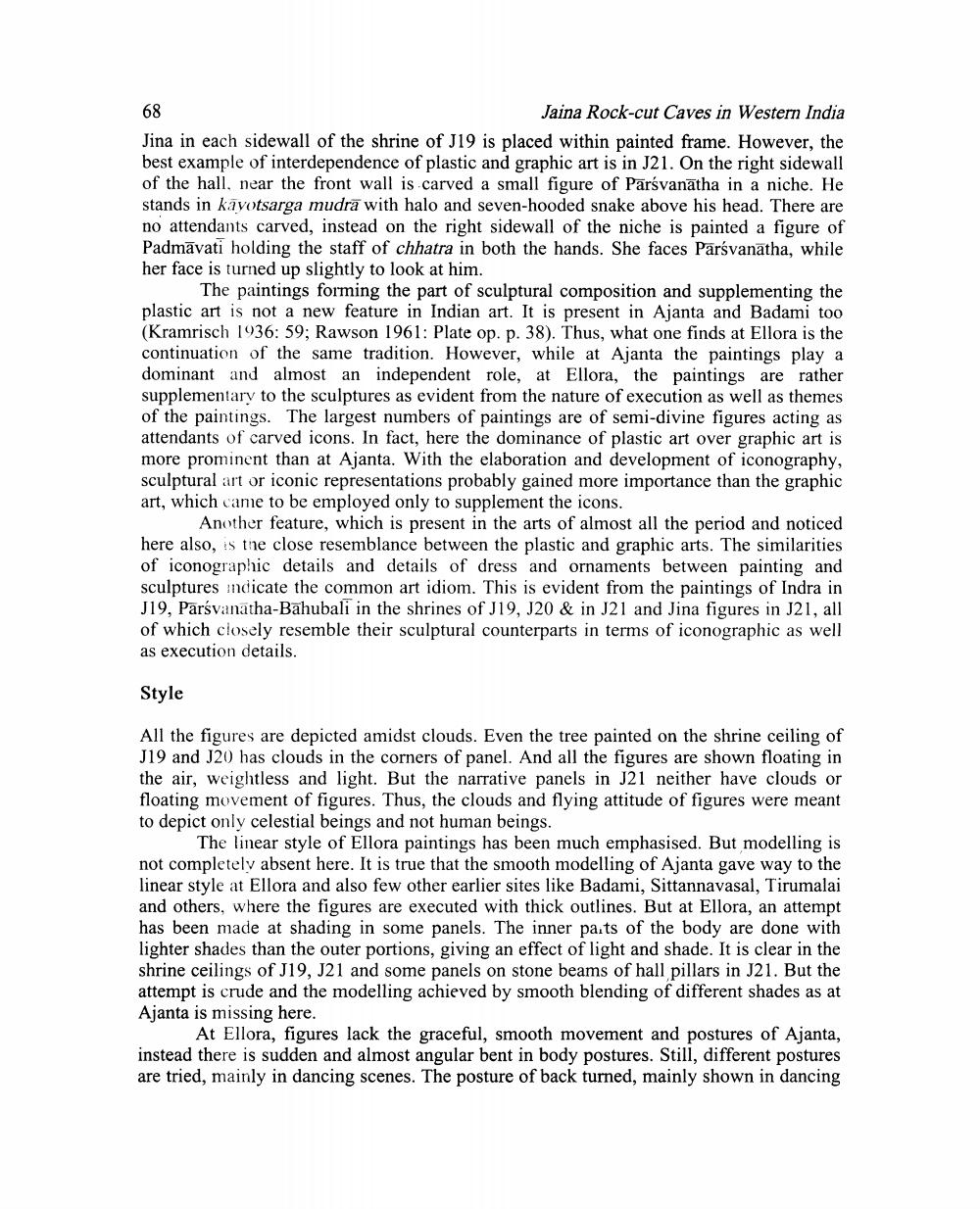________________
68
Jaina Rock-cut Caves in Western India Jina in each sidewall of the shrine of J19 is placed within painted frame. However, the best example of interdependence of plastic and graphic art is in J21. On the right sidewall of the hall. near the front wall is carved a small figure of Parsvanatha in a niche. He stands in kayotsarga mudra with halo and seven-hooded snake above his head. There are no attendants carved, instead on the right sidewall of the niche is painted a figure of Padmavati holding the staff of chhatra in both the hands. She faces Parsvanatha, while her face is turned up slightly to look at him.
The paintings forming the part of sculptural composition and supplementing the plastic art is not a new feature in Indian art. It is present in Ajanta and Badami too (Kramrisch 1936: 59; Rawson 1961: Plate op. p. 38). Thus, what one finds at Ellora is the continuation of the same tradition. However, while at Ajanta the paintings play a dominant and almost an independent role, at Ellora, the paintings are rather supplementary to the sculptures as evident from the nature of execution as well as themes of the paintings. The largest numbers of paintings are of semi-divine figures acting as attendants of carved icons. In fact, here the dominance of plastic art over graphic art is more prominent than at Ajanta. With the elaboration and development of iconography, sculptural art or iconic representations probably gained more importance than the graphic art, which came to be employed only to supplement the icons.
Another feature, which is present in the arts of almost all the period and noticed here also, is the close resemblance between the plastic and graphic arts. The similarities of iconographic details and details of dress and ornaments between painting and sculptures indicate the common art idiom. This is evident from the paintings of Indra in J19, Parsvanatha-Bahubali in the shrines of J19, J20 & in J21 and Jina figures in J21, all of which closely resemble their sculptural counterparts in terms of iconographic as well as execution details.
Style
All the figures are depicted amidst clouds. Even the tree painted on the shrine ceiling of J19 and J20 has clouds in the corners of panel. And all the figures are shown floating in the air, weightless and light. But the narrative panels in J21 neither have clouds or floating movement of figures. Thus, the clouds and flying attitude of figures were meant to depict only celestial beings and not human beings.
The linear style of Ellora paintings has been much emphasised. But modelling is not completely absent here. It is true that the smooth modelling of Ajanta gave way to the linear style at Ellora and also few other earlier sites like Badami, Sittannavasal, Tirumalai and others, where the figures are executed with thick outlines. But at Ellora, an attempt has been made at shading in some panels. The inner parts of the body are done with lighter shades than the outer portions, giving an effect of light and shade. It is clear in the shrine ceilings of J19, J21 and some panels on stone beams of hall pillars in J21. But the attempt is crude and the modelling achieved by smooth blending of different shades as at Ajanta is missing here.
At Ellora, figures lack the graceful, smooth movement and postures of Ajanta, instead there is sudden and almost angular bent in body postures. Still, different postures are tried, mainly in dancing scenes. The posture of back turned, mainly shown in dancing




